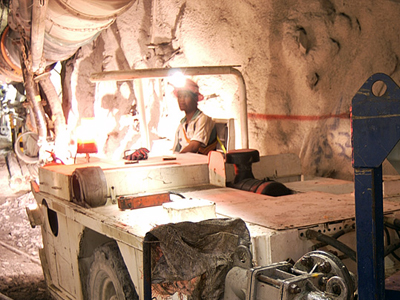Workers at AngloGold Ashanti’s Mponeng operation must withstand the heat of deep underground mining.
“Deep underground, deep sky and deep sea” comprise the lofty goals of Three Deep, a five-year program announced last month by China’s Ministry of Land and Resources. Part 1 of this feature looked at the country’s ambitions to take mineral exploration deeper than ever on land, at sea and into the heavens, and also outlined other countries’ space programs related to mineral exploration. Part 2 delves into undersea mining as well as some of the world’s deepest mines.
Looking to the ocean depths, undersea mining has had tangible success. De Beers has been scooping up alluvial diamonds off southwestern Africa for decades, although at shallow depths. Through NamDeb, a 50/50 JV with Namibia, a fleet of six boats mines the world’s largest-known placer diamond deposit, about 20 kilometres offshore and 150 metres deep.
Diamond Fields International TSXV:DFI hopes to return to its offshore Namibian claims, where the company extracted alluvial stones between 2005 and 2008. The company also holds a 50.1% interest in Atlantis II, a zinc-copper-silver deposit contained in Red Sea sediments. That project’s now on hold pending a dispute with the Saudi Arabian JV partner.
With deeper, more technologically advanced ambitions, Nautilus Minerals TSX:NUS holds a mining licence for its 85%-held Solwara 1 project in Papua New Guinea waters. A seafloor massive sulphide deposit at an average depth of 1,550 metres, its grades explain the company’s motivation. The project has a 2012 resource using a 2.6% copper-equivalent cutoff, with the Solwara 1 and 1 North areas showing:
-- indicated: 1.03 million tonnes averaging 7.2% copper, 5 g/t gold, 23 g/t silver and 0.4% zinc
-- inferred: 1.54 million tonnes averaging 8.1% copper, 6.4 g/t gold, 34 g/t silver and 0.9% zinc
Using the same cutoff, the Solwara 12 zone shows:
-- inferred: 2.3 million tonnes averaging 7.3% copper, 3.6 g/t gold, 56 g/t silver and 3.6% zinc

This Nautilus diagram illustrates the proposed Solwara operation.
A company video shows how Nautilus had hoped to operate “the world’s first commercial high-grade seafloor copper-gold mine” beginning in 2018 using existing technology from land-based mining and offshore oil and gas. Now, should financial restructuring succeed, Nautilussays it could begin deployment and testing by the end of Q1 2019.
Last May Nautilus released a resource update for the Clarion-Clipperton Fracture Zone in the central Pacific waters of Tonga.
Another deep-sea hopeful, Ocean Minerals last month received approval from the Cook Islands to explore a 12,000-square-kilometre seabed expanse for rare earths in sediments.
A pioneer in undersea exploration, Japan’s getting ready for the next step, according to Bloomberg. A consortium including Mitsubishi Heavy Industries and Nippon Steel & Sumitomo Metal will begin pilot mining in Chinese-contested waters off Okinawa next April, the news agency stated. “Japan has confirmed the deposit has about 7.4 million tons of ore,” Bloomberg added, without specifying what kind of ore.
Scientists are analyzing data from the central Indian Ocean where nodules show signs of copper, nickel and manganese, the Times of India reported in January. The country has an ROV capable of an unusually deep 6,000 metres and is working on undersea mining technology.
In August the World Nuclear News stated Russia is considering a nuclear-powered submarine to explore northern seas for mineral deposits. A government report said the sub’s R&D could put the project on par with the country’s space industry, the WNN added.
If one project alone could justify China’s undersea ambitions, it might be a 470.47-ton gold deposit announced last November. Lying at 2,000 metres’ depth off northern China, the bounty was delineated by 1,000 workers and 120 kilometres of drilling from 67 sea platforms over three years, the People’s Daily reported. Laizhou Rehi Mining hopes to extract the stuff, according to China Daily.
China’s deep underground ambitions might bring innovation to exploration but have been long preceded by actual mining in South Africa—although not without problems, as the country’s deplorable safety record shows. Greater depths bring greater threats from rockfalls and mini-earthquakes.
At 3.9 kilometres’ depth AngloGold Ashanti’s (NYSE:AU) Mponeng holds status as the world’s deepest mine. Five other mines within 50 kilometres of Johannesburg work from at least three kilometres’ depth, where “rock temperatures can reach 60 degrees Celsius, enough to fry an egg,” according to a Bloomberg article posted by Mineweb.com.
In his 2013 book Gold: The Race for the World’s Most Seductive Metal, Matthew Hart recounts a visit to Mponeng, where he’s told a “seismic event” shakes the mine 600 times a month.
Sometimes the quakes cause rockbursts, when rock explodes into a mining cavity and mows men down with a deadly spray of jagged rock. Sometimes a tremor causes a “fall of ground”—the term for a collapse. Some of the rockbursts had been so powerful that other countries, detecting the seismic signature, had suspected South Africa of testing a nuclear bomb.
AngloGold subjects job-seekers to a heat-endurance test, Hart explains.
In a special chamber, applicants perform step exercises while technicians monitor them. The test chamber is kept at a “wet” temperature of eighty-two degrees. The high humidity makes it feel like ninety-six. “We are trying to force the body’s thermoregulatory system to kick in,” said Zahan Eloff, an occupational health physician. “If your body cools itself efficiently, you are safe to go underground for a fourteen-day trial, and if that goes well, cleared to work.”
Clearly there’s more than technological challenges to mining the deeps.
By the way, credit for the world’s deepest drilling goes to Russia, which spent 24 years sinking the Kola Superdeep Bore Hole to 12,261 metres, halfway to the mantle. Work was halted by temperatures of 180 degrees Celsius.
Source: http://resourceclips.com/2016/10/12/pushing-the-boundaries/

